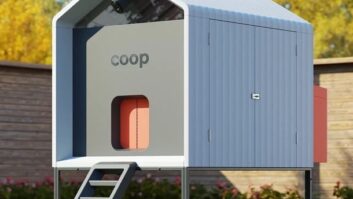Despite rising raw materials costs, the prospect of higher mortgage rates and a sluggish outlook for sales (see story, next page), major appliance manufacturers are optimistic that new product innovations and production efficiencies will help buoy the white-goods business through the balance of 2005.
“We expect demand for appliances during the second half of 2005 to be about even with the same period last year,” observed Lynn Pendergrass, marketing and product management VP for GE Consumer & Industrial. “Although growth in appliance sales has slowed from the torrid pace of last year, 2005 continues to be a good year for the industry and for GE.”
According to Pendergrass, factors working in majaps’ favor include continued strong housing activity, a key driver of appliance sales. “Despite the continued boost in short-term interest rates, long-term rates remain at historical low levels,” she said. “As a result, both new residential construction and the turnover of existing homes have maintained a favorable pace for appliance demand. The large number of housing units started in the first half of 2005 will ensure significant completion activity for the balance of the year, even if mortgage rates begin to move higher.”
Pendergrass added that majap sales are also benefiting from the growth in employment and the attendant gains in income.
Christine Lewis, appliances senior director at Sharp, believes that “consumer spending on remodeling and home improvements will have a positive effect on business in the short term.” In the Northeast alone, remodeling spending has increased over 50 percent in the past five years, she said, citing data from the National Kitchen and Bath Association (NKBA), while total 2005 expenditures are expected to hit $256 billion according to the National Association of the Remodeling Industry (NARI).
Teddy Hwang, president of LG’s Digital Appliances division agrees. “People are continuing to invest in their homes, and the home improvement centers and retail channels where appliances are sold are seeing increased sales. We have seen that over the past couple of years, even when the economy was not as strong as we would have liked.”
But booms in housing and home improvement aside, manufacturers must still grapple with the rising cost of fuel and raw materials. “We’ve been dealing with high material costs for almost a year,” noted David Swift, executive VP of Whirlpool’s North American region, “and have taken the necessary actions to control them through significant productivity improvements and holding down unnecessary spending.
“Also, as we announced last year, we’ve successfully initiated 5 percent to 10 percent price increases across the board,” Swift continued. “Going forward, we will continue to take the necessary steps and adjustments to our business to maintain Whirlpool’s leadership [position].”
Raw material costs also remain a concern to GE. “Commodity and transportation prices continue to create intense pressure on our cost to produce and distribute appliance products,” Pendergrass said. “We have seen little relief in the cost of steel, while oil remains over $50 per barrel.” In response GE is “aggressively working to reduce cost, and [has] increased wholesale prices in an effort to offset these inflationary pressures. We are optimistic that our actions will continue to allow us to invest in new products and deliver value to the consumer.”
For BSH Home Appliances, “Steel and plastic prices affect us the most,” said president/CEO Franz Bosshard. “This year we continue to price our products competitively and are still able to offer the consumer the highest quality appliance and a fair price.”
Similarly, LG’s Hwang acknowledged that “raw material costs as well as increased oil and transportation prices have affected the entire industry globally. To combat this,” he said, “LG continues to focus on improving productivity along with streamlining our manufacturing processes. Additionally, we continue to examine our product portfolio and bring to market the products that best meet the needs of today’s consumers. We believe that consumers will continue to demand more from their appliances in terms of design and features, and will be willing to invest in products that not only get the job done, but also look good while doing it.”
Indeed, product innovation continues to spark consumer excitement and sales. As Maytag’s senior VP/sales Paul Bognar observed, “Consumers are seeking appliances that allow them to enjoy more life and bring new looks to their homes. This is why we are launching a number of new products in 2005” — including Jenn-Air’s full-line of glass panel appliances and new platinum and silver metallic fashion colors for Neptune — “that continue our leadership in quality, dependability and innovation.”
Jim Bakke, president/CEO of Sub-Zero and Wolf Appliances, concurred that “despite slowly climbing mortgage rates, consumers are still intent in investing to create their dream kitchen and the ultimate space for entertaining family and friends and creating great meals.” To help fulfill those aspirations, the company is preparing to launch a new commercial-look PRO 48 refrigerator for Sub-Zero and a 15-inch induction cooktop module for Wolf.
Looking ahead, Sharp’s Lewis is “very optimistic” about the next six months for both the industry and her company. “Our product distribution has been expanding at the rate we planned, and we anticipate that we will continue to be successful in this time period,” she said, thanks in large measure to “highly differentiated products that answer a particular need for the consumer.”
Samsung Digital Appliances, which achieved a major toehold in the U.S. market through its partnership with Best Buy, will enter a second phase of domestic growth this September when it begins supplying No. 2 majap retailer Lowe’s. “We are expanding our product assortment and distribution,” said president H.B. Lee. Besides the home improvement channel, Lee said Samsung is also reaching out to regional chains and independent dealers as well as warehouse clubs, where the company already maintains a presence at Costco.
“We will be selective in distribution and we won’t cut prices,” said Lee. “We are looking for select channels that can explain our unique technologies and that match our target demographic of higher education and income levels.”
He added that Samsung is systematically adding new categories to its U.S. lineup, including dishwashers and freestanding ranges this year and laundry in 2006, in order to offer “complete packages and total solutions” to its channel partners.
Similarly, BSH’s Bosshard expects to maintain “strong growth” following last year’s 50 percent-plus sales strides “because of key core products that are a proven success in the market, along with our expansion into new arenas including laundry and freestanding ranges for Bosch and a line extension of Thermador’s Professional Series with the Pro Harmony.”













